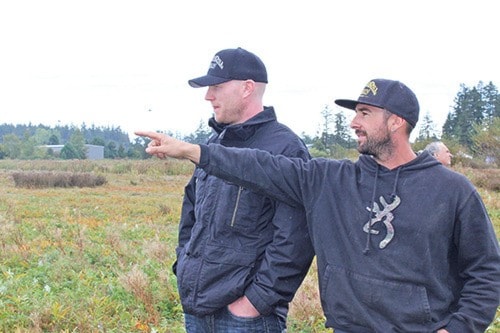It was a rainy first open house Saturday on the Maber Flats site, as community members gathered to learn more about the Central Saanich water retention agricultural project.
The 25-acre parcel of agricultural land that floods seasonally has been a topic of concern among residents in and out of the area.
Clayton Fox, who lives beside the Maber Flats area, said he’s happy to see it moving forward as they haven’t been able to use their land effectively for years.
“It’s a 22 acre piece over there, so it’s the most affected piece to this project,” he said, adding there’s an increasing amount of water entering the area, so the water table is too high to farm well.
“It just keeps getting worse ... because of new development in the area and more run-off water and things like that, so it’s pretty much been like a stagnant piece of land for us for six or seven years. We haven’t even been able to plant on it so it forces us to lease other areas.”
His father grew sweet corn back in the 1990s, which took up close to 100 acres.
“It started getting worse to the point where he started looking for other areas to farm a bit and then at that point it was flooding more and more.”
Fox’s brother-in-law Russ Taylor also likes the project.
“We’re all for it obviously, it’s a family farm. We end up leasing other land because we can’t use the fields that we own, so it costs us extra money and time obviously, like having to farm further away, so we’re all for it,” he said.
Aqua-Text Scientific Consulting Ltd. was hired by the District of Central Saanich and is at the information gathering stage. The company is consulting with the community to pull together background information and collect any historical information they can about the site.
Aqua-Tex is also trying to consult with people about current uses and the wish list of what people want to see there.
“And then our job is to try and integrate that with the zoning requirements, the agricultural land commission requirements and the District’s requirements,” said Project Manager Cori Barraclough.
On Saturday, members of the community toured the site and learned about the different soil profiles, along with the landscape context.
“Today, we’re simply trying to explain to people what the general intention of the project is, trying to help people understand a little about ecology about the soils and the landscape context; where the water comes from, where the water goes, what the land uses are around the area,” said Barraclough.
Some who attended the open house were not completely in favour of the project.
Larry Sluggett, who is on the Peninsula and Area Agricultural Commission (PAAC), has concerns primarily about the benefits and whether there really are any.
“The plan is to build a 20 or 25 acre lake to gather water,” he said. “The farming community feels that they don’t have enough information to justify it.”
Sluggett said some farmers believe there’s not enough information to show that it actually will benefit local agriculture. He said for now it should be left alone, as it doesn’t really get used anymore.
“When I was a youngster this was all used for potatoes. That’s where the name Maber comes from … and so it’s really productive soil but because it got farmed year after year and [it became] peat soil.
“Peat soil is basically organic matter that slowly rots and as it rots, it sinks and so because this has been farmed continuously for about 70 years, it’s gotten lower and as a result it stays wet way later. It stays wet into June.”
Sluggett, along with others of PAAC, will be meeting with the consultant to help resolve their issues.
Terry Michell, a PAAC member and with the Central Saanich Agricultural Advisory Committee, said he also doesn’t agree fully yet with the project.
“What I’m somewhat against is taking basically 15 or 18 acres of farmland to build a holding pond... There must be other avenues they could take before digging a large hole on a piece of agricultural land.
“I’m not sure if they’ve explored all their avenues before they go ahead with the project.”
Aqua-Tex will complete preliminary design work, taking the background and hydrological information to come up with some concept plans. They plan to show those plans to the community for further feedback.
From that consultation process, the company will refine the design again, consulting with local groups and the public to hopefully come up with a design that works for everybody.
No cost estimate is provided yet, as that will be driven by the final design plan, to be presented to the District of Central Saanich at a later date.
